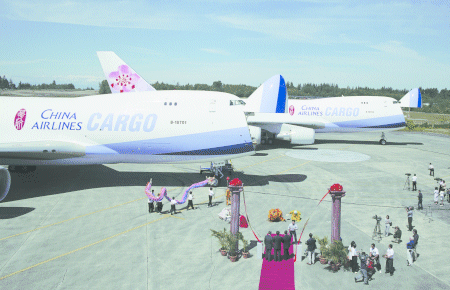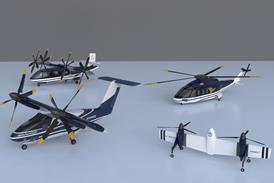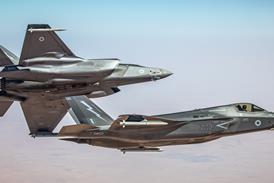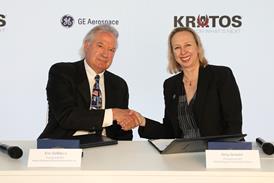Brent Hannon/TAIPEI Andrzej Jeziorski/SINGAPORE
Hong Kong is acknowledged as one of the world's busiest air cargo hubs. As a small, export-oriented territory, Taiwan is an attractive market for cargo airlines. The pair's fortunes are linked by relations with mainland China. Analysts point out that episodes of increased tension between Taipei and Beijing have had little effect on cargo traffic through Taiwan, with its strong exports of high value-added manufactured goods. But some believe a thaw between Taiwan and mainland China could draw mainland traffic away from Hong Kong if it led to the opening up of direct air links between Taiwan and the mainland.
Airline analyst Peter Negline of Jardine Fleming believes a thaw in relations across the Taiwan Straits could open up hitherto untapped potential for Taipei as a trans-shipment centre. "The degree to which that would happen is a function of sustainable economic growth in the 'greater China' economy," he says.
If this growth were sufficiently strong, both Hong Kong and Taiwan could benefit equally from the additional revenue. Furthermore, until mainland China improves its airports' reputation for excessive bureaucracy, undue delays in customs, and pilfering, both territories' status as preferred cargo destinations for "greater China" is likely to remain unchallenged.
Dominant in Hong Kong
As the Chinese Special Administrative Region's dominant airline, Cathay Pacific Airways has played a key part in establishing Hong Kong as a major air cargo hub.
But Cathay, which has grown from a small freight operation in 1946 to one of the world's top 10 cargo airlines today, faces competition from its erstwhile subsidiary, now rival, Dragonair. The smaller carrier, which previously focused on regional passenger routes, has begun all-cargo services to Amsterdam, Dubai, Manchester and Shanghai with a wet-leased Boeing 747-200F freighter, and plans to expand. Ambitious Dragonair says it hopes to operate five freighters in the coming years, as it almost doubles its passenger fleet to 26 aircraft. But the carrier still has some catching up to do if it is to become a serious thorn in Cathay's side.
Having just taken delivery of its tenth dedicated freighter (including three Boeing 747-200F aircraft leased out to its 75%-owned cargo subsidiary Air Hong Kong) Cathay has announced further plans to expand its freight operation. The new aircraft is a Boeing 747-400F - Cathay's third, with another two due for delivery in April and August next year.
Cathay also operates four 747-200Fs on top of the three Air Hong Kong aircraft, and acknowledges that these are rather old. Soon replacements will be needed, which are likely to lead to more -400F orders.
Cathay general manager cargo Kenny Tang says expanding its freighter fleet will "further strengthen Hong Kong's position as the world's leading hub for international air cargo". The 747-400F has a 120t cargo capacity - 25t more than the 747-200F - with a 15% lower fuel burn. Cathay says this extra range makes its latest addition suitable for opening up its first non-stop cargo services to London. The other two Cathay 747-400Fs have been serving North American destinations up to now.
The airline also utilises cargo space on its passenger aircraft, and says this capacity has grown rapidly since it introduced Airbus A330s, A340s, and Boeing 777s to its fleet. "Today, Cathay Pacific Cargo can carry over 50,000t of cargo per month, with more than half being uplifted on passenger flights," says Cathay.
Like every carrier in Asia, Cathay suffered in the economic crisis in mid-1997. But its cargo business has continued to grow, becoming an increasingly important part of its business. Cargo accounted for 27.3% of overall revenue in 1999, and 28.5% of the airline's turnover in the first half of this year - compared with 27.5% in the corresponding half of 1999.
In adding three new destinations - New Delhi, the Malaysian island of Penang, and San Francisco - by the end of September, the airline's freighter fleet will cover 19 destinations worldwide. No more new destinations are planned for the next two 747-400Fs due for delivery, but they will allow frequencies to be increased on existing services. The carrier is confident of double-digit percentage cargo traffic growth for this year as a whole. Contributing to this is a unique partnership with DHL Worldwide Express, which began in March.
Under this partnership, Cathay carries DHL freight on overnight flights to four Asian destinations on passenger aircraft which would otherwise remain parked. The service comprises 32 flights weekly to Osaka, Seoul, Singapore and Taipei, with a few passengers allowed on most flights.
Charles Longley, DHL chief executive for Asia-Pacific and the Middle East, has told Flight International's sister online service ATI that the agreement may be extended after its initial three years, covering more Asian destinations, possibly using dedicated freighters. The deal is understood to be bringing Cathay $70 million to $100 million in additional revenue.
Taiwan's cargo growth
Taipei-based China Airlines (CAL) is now the tenth largest cargo carrier in the world, measured by cargo tonne kilometres, while EVA derives over 40% of its revenue from cargo, and is aiming for 50%. For both airlines, cargo revenue is growing faster than passenger revenue.
In 1999, CAL cargo revenue grew 20.4% compared with 1998, to NT$21.06 billion ($680 million), and cargo traffic grew 19.7%, to 3.4 billion revenue freight tonne kilometres. By comparison, passenger revenue grew 15.7%. Also in 1999, cargo capacity grew 18.9%, to 4.1 billion available tonne kilometres. CAL's average cargo load factor was 83.9%, an increase of 0.6% from 1998, while yields rose 0.6% to NT$6.13 per freight tonne kilometre. CAL earned 37% of its 1999 revenue from cargo. The growth continued in the first half of 2000, as CAL's cargo load factor reached 84.7%, and cargo revenue NT$11.4 billion.
The USA is Taiwan's top cargo destination. Last year, 52% of CAL's cargo revenue came from Trans-Pacific routes, which account for just 30% of its passenger revenue. On European routes, CAL gains 21% of its cargo revenue and just 9% of its passenger revenue. On South-East Asian routes, passenger and cargo revenues are about equal, while on routes to Japan the situation is reversed: 17% of CAL's passenger revenue derives from Japan traffic, compared with just 5% of its cargo revenue.
The situation is similar for EVA: it derives 52% of its cargo revenue from the USA, 25% from Europe, and 23% from Asia. CAL, like EVA, has made Anchorage its US freight hub. From Anchorage, it has direct cargo flights to San Francisco, Los Angeles, Dallas, Atlanta, Chicago, Miami and New York. Much of the trans-Pacific and European air freight is time-sensitive high-tech equipment for which customers will pay a premium for prompt delivery. Computer chips and chipsets, LCD screens, keyboards, power supplies and other items produced in Asia are shipped through Taipei to the USA and Europe.
The recent regional financial crisis, which sharply devalued many Asian currencies, boosted regional exports. Increased frequencies to South-East Asia and the USA are paying off for both airlines. Before direct flights to Penang, for example, all cargo went through Singapore, but it can now transit through Taipei. Some of the traffic flows both ways: parts and materials from the USA, Europe and Taiwan are made into electronic products in Asia, then re-exported back to the USA and Europe. Much of the tooling and machinery used in Asia's high-tech industries is shipped from the USA.
EVA ordered three Boeing 747-400Fs so it could carry the heavy machinery, because the cargo doors on its MD-11Fs are too small, says deputy senior vice-president K.W. Nieh. While high-tech items represent about 70% of total cargo shipments, the two carriers also deliver a steady flow of sporting goods, shoes, optical accessories, fashion garments and agricultural products. Both airlines are increasing their capacity. In July and August, CAL took delivery of three new Boeing 747-400Fs, increasing its cargo capacity by more than 30%. The new freighters are part of a 1999 order for 17 Boeing 747-400Fs, the largest order Boeing has ever received for that aircraft type. The remaining 14 aircraft will arrive by 2007, and CAL will eventually retire its eight Boeing 747-200Fs.
CAL has increased all-cargo flights from 41 per week to 53 per week, including an increase in trans-Pacific flights from 19 to 27, European routes from nine to 10 per week and regional routes from 14 to 16 per week.

The new aircraft can carry 115 to 120 tonnes of cargo, an increase of 25 tonnes compared with the 747-200Fs, and deliver a 15% fuel saving. EVA is also adding three new Boeing 747-400Fs. The first was delivered in July with the second due in 2001 and the third in 2002. EVA can use the capacity: "We don't think we [will] have any trouble filling up the three 747-400 freighters," says Nieh. Cargo also played a role in EVA's June order for three Boeing 777-200s and four 777-300s, plus eight options, as a 777 can carry 30% more belly cargo than a 747-400.
Load factor fluctuations
Capacity planning for cargo operations is tricky. During peak season, the carriers have too little capacity, while during the low season, load factors drop dramatically. Peak times include weekends, the end of the month and June to November, while the slowest period is January and February.
Unlike CAL, EVA flies 747-400 Combi aircraft which can carry seven upper deck pallets. This allows the carrier to fly 35 to 40t of cargo, compared with just 10t in the belly of a passenger 747-400. It carries 270 passengers.
For EVA, as for CAL, 2000 has been a good year. Its cargo load factor is predicted to reach 85.2% for the year, compared with 79.22% in 1999, while freight tonne kilometres will grow from 3.36 million in 1999, to a predicted 3.86 million.
As an established airline, CAL carries most of Taiwan's cargo, while EVA has been forced to find South-East Asian cargo traffic, says Nieh. In the first seven months of 2000, EVA's cargo revenue grew 16.7%, to NT$12.4 billion, accounting for 40.7% of its total revenue through to the end of July. Passenger revenue grew 9.5%in the same period.
Source: Flight International























